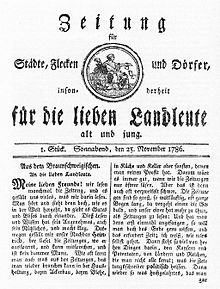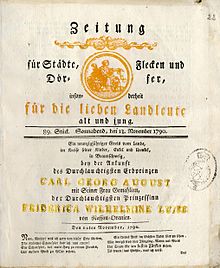Newspaper for cities, towns and villages
The newspaper for cities, spots and villages , also known as the Rothe Zeitung because of its red headline , first appeared on November 25, 1786 in Wolfenbüttel . Until his death in 1797, the publisher was the Protestant pastor Hermann Bräss .
history
The full title of the newspaper read: Newspaper for cities, towns and villages, especially for the dear country people old and young. With the approval of the Brunswick Duke Karl Wilhelm Ferdinand, it appeared initially two times a week, later three times a week in the Wolfenbüttel printing house Bindseil, initially comprised four, then later eight quarter pages and cost "8 good groschen " a quarter. The "Rothe Zeitung" is the forerunner of the Wolfenbütteler Zeitung, which existed until 1993 . The newspaper was sent postage paid by carriage either from the Ducal Intelligence Comptoir in Braunschweig or from the Bindseilschen printing works in Wolfenbüttel. It was particularly successful in northern Germany , with print runs of 526 copies in 1788 and 1600 in 1792. Bräss received political information from Hamburgische Correspondenz , a Hamburg newspaper that had a large network of correspondents . For ten years, until his death in 1797, Bräss wrote most of the articles himself and was their sole editor. After Bräss' death, Bindseil continued the newspaper. From 1873 the newspaper appeared as Wolfenbütteler Kreisblatt, then as Wolfenbütteler Zeitung.
particularities
Goal setting
Born in Braunschweig in 1738 , Bräss studied theology at the University of Helmstedt and was inspired on the one hand by the ideas of the Enlightenment and rationalism , on the other hand by humanistic ideals. He also understood Christian charity as practical help in raising children and the poor. After receiving the pastor's post in the village of Dettum , near Wolfenbüttel, in 1773 , from 1786 he made it his task with his newspaper to educate the rural population, whom he viewed as being superstitious , by giving them agricultural and domestic knowledge , but also sought to convey socio-political information.
Structure and content
Bräss tried to achieve his goals by placing particular emphasis on the general intelligibility of the texts . He not only wrote almost all of the texts himself, but also prepared them “close to the people” - e.g. B. through the use of Low German spoken in the region . Foreign words and foreign proper names transcribed it phonetically . He formulated it in a simple, concise and clear manner and occasionally also commented on his contributions, which was an absolute novelty at the time . The content was grouped by topic. First there were general considerations by the editor, who was never mentioned by name in any edition, but was soon known as Pastor Bräss from Dettum. This was followed by events of contemporary history, texts on agriculture, horticulture and natural sciences. This was followed by texts for teachers that should be copied in schools. The event ended with anecdotes , polemics and “The latest in a nutshell”. The “Rothe Zeitung” is considered to be one of the few successful attempts at that time to inform the readership in easily understandable language about events from science, culture, society and politics.
The newspaper was initially relatively apolitical, but that changed with the beginning of the French Revolution . In the course of the French events, which Bräss, who had worked in Paris in 1768 , followed closely and commented on, the journalistic focus shifted to the area of “world trade”. After the pastor was politically classified as "harmless" in the early days of his newspaper, he and his editorship increasingly came into conflict with the censorship organs of the Duchy of Braunschweig-Lüneburg , especially when its domestic or foreign policy interests were affected, such as B. in the student unrest at the University of Helmstedt or the Wöllner religious edict .
Letters to the editor
The “Rothe Zeitung” was the first German-language newspaper to actively advertise among its readership for letters to the editor and also to print them.
Preserved copies
The first editions of the “newspaper for cities, spots and villages” are now in Wolfenbüttel in the Herzog August Library and the State Archives there, as well as in the Braunschweig City Library . Another copy is privately owned by a descendant of Pastor Bräss. Another extremely rare original from the first edition of November 25, 1786 was discovered in an attic by private individuals from Wolfenbüttel in the 2000s.
literature
- Fritz Barnstorf: Pastor Hermann Braess (1738–1797), the Dettumer Bote and Brunswick household friend with his “Rothen Zeitung for the dear country people”. In: Braunschweigische Heimat. 52nd year 1966, pp. 128-134.
- Britta Berg: Newspapers and magazines from Braunschweig including Helmstedt (until 1810) and Wolfenbüttel (until 1918) , In: Braunschweiger Werkstücke , publications from the city archive and the city library, Series A, Volume 40, The whole series Volume 93, Braunschweig 1995, ISBN 3-930459-08-6 .
- Holger Böning : The “newspaper for cities, towns and villages, especially for dear country folk, old and young” - a first successful “people's newspaper” of the 18th century. In: Peter Albrecht and Holger Böning (eds.): Historical press and their readers: Studies on newspapers and magazines, intelligence papers and calendars in Northwest Germany. Edition lumière, Bremen 2005, ISBN 978-3934686236 , pp. 227-264.
- Jürgen Engelking: Bräß, Hermann Werner Dietrich , In: Horst-Rüdiger Jarck, Dieter Lent et al. (Ed.): Braunschweigisches Biographisches Lexikon. 8th to 18th centuries. Appelhans, Braunschweig 2006, ISBN 3-937664-46-7 , p. 105 f.
- Andrea Mlitz: Dialogue-oriented journalism. Letters to the editor in the German daily press. UVK Verlagsgesellschaft, Konstanz 2008, ISBN 978-3867640503 .
- Peter von Polenz : German language history from the late Middle Ages to the present. Volume 2: 17th and 18th centuries. De Gruyter, Berlin 1994, ISBN 978-3110134360 .
- Eckart Roloff : Hermann Bräß - A country pastor creates the letter to the editor. In: Eckart Roloff: Divine flashes of inspiration. Pastors and priests as inventors and discoverers. 2nd updated edition 2012, Wiley-VCH, Weinheim 2010, ISBN 978-3-527-32864-2 , pp. 183-196.
- Martin Welke: A pioneering journalistic achievement. In: 200 years of Wolfenbütteler Zeitung. Special edition of November 25, 1986, pp. II – V.
Individual evidence
- ↑ a b c Fritz Barnstorf: Pastor Hermann Braess (1738–1797), the Dettumer Bote and Brunswick family friend with his “Rothen Zeitung for the dear country people”. P. 131
- ↑ a b c d e Fritz Barnstorf: Pastor Hermann Braess (1738–1797), the Dettumer Bote and Brunswick household friend with his “Rothen Zeitung for the dear country people”. P. 128
- ^ A b c Jürgen Engelking: Bräß, Hermann Werner Dietrich , In: Jarck, Lent et al. (Hrsg.): Braunschweigisches Biographisches Lexikon. 8th to 18th centuries. , P. 105
- ^ Britta Berg: Newspapers and magazines from Braunschweig including Helmstedt (until 1810) and Wolfenbüttel (until 1918) , p. 30
- ↑ a b Pastor Bräss was a typical enlightener. Braunschweiger Zeitung , January 11, 2013
- ↑ Fritz Barnstorf: Pastor Hermann Braess (1738–1797), the Dettumer Bote and Brunswick household friend with his “Rothen Zeitung for the dear country people”. P. 133
- ^ A b Jürgen Engelking: Bräß, Hermann Werner Dietrich , In: Jarck, Lent et al. (Hrsg.): Braunschweigisches Biographisches Lexikon. 8th to 18th centuries. , P. 106
- ↑ Fritz Barnstorf: Pastor Hermann Braess (1738–1797), the Dettumer Bote and Brunswick household friend with his “Rothen Zeitung for the dear country people”. P. 129
- ↑ Andrea Mlitz: Dialog- oriented journalism. Letters to the editor in the German daily press. , P. 165
- ↑ "Rothe-Zeitung" from 1786 discovered. Braunschweiger Zeitung, January 5, 2013.

